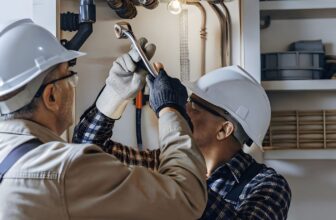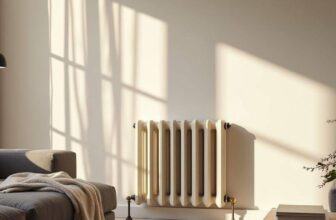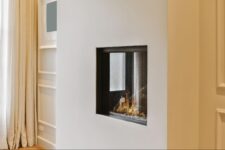
Cassette Stove Building – What is a Cassette Stove?

There’s something timeless about a crackling fire. It brings comfort, warmth, and a sense of calm that no radiator or electric heater can match. But while traditional wood-burning stoves and open fires offer charm, they often fall short when it comes to efficiency, safety, and ease of use. That’s where the cassette stove comes in – a sleek, modern alternative that combines the beauty of burning wood with superior heat output and smart design. Perfect for modern homes or those upgrading an existing fireplace, cassette stoves have become a popular choice for homeowners looking to balance aesthetic appeal with functionality. They’re particularly suited to larger spaces, offering consistent warmth and a high level of heat retention. In this article, we’ll break down exactly what a cassette stove is, how it compares to regular stoves, and what’s involved in building and installing one; from choosing materials to planning around your chimney breast and flue liner. Whether you’re creating a new feature wall or retrofitting into an old hearth, a cassette stove could be the perfect solution to bring real, reliable warmth back into your living space.
What Is a Cassette Stove?
A cassette stove is a type of inset wood-burning stove that is built directly into a wall or chimney breast, rather than standing freely on a hearth like most regular stoves. These stoves are designed to sit flush with the wall, creating a clean, integrated look that’s ideal for both minimalist and modern interiors.
At its core, a cassette stove is a sealed firebox, typically made from steel or another durable metal, with a large glass front that gives you a clear view of the flames. It’s essentially a wood burner that slots into the existing fireplace or a custom-built recess, offering the visual appeal of a real fire but with much higher efficiency and better control.
What sets it apart from traditional wood-burning stoves is not just its appearance, but how it functions. The sealed design allows for far greater heat retention, meaning more hot air stays in the room instead of escaping up the flue. Combined with carefully engineered air vents, this makes the cassette stove a highly efficient way to heat your living space, even in large rooms or open-plan layouts.
These stoves can run on seasoned wood, logs, or smokeless coal, and many are DEFRA approved – making them suitable for smoke control areas across the UK. Some models also support multi-fuel use or come in gas or electric versions, offering more flexibility depending on your heating needs.
In short, a cassette stove brings together the best of both worlds: the warmth and beauty of a wood-burningreal fire, and the convenience, safety, and efficiency of modern design. It’s not just about keeping your house warm – it’s about doing it in style.
Cassette Stove vs. Traditional Wood-Burning Stoves
While cassette stoves and traditional wood-burning stoves both run on burning wood or smokeless coal, their design and performance are worlds apart. Understanding the differences can help you decide which is more suitable for your living space.
Traditional wood-burning stoves are freestanding units, usually positioned on a hearth with the flue pipe exposed or leading up through the chimney. They’re often bulky and protrude into the room, which can limit your layout and design choices.
By contrast, a cassette stove is an inset stove. It’s fitted directly into a chimney breast or recess and is designed to sit flush with the wall. This offers a cleaner, more streamlined look and saves space – particularly useful in modern homes where open-plan design and minimalism are key.
From a technical standpoint, cassette stoves are typically more efficient. Their sealed firebox and advanced air vents allow for a controlled burn that maximises heat output and minimises waste. In an open fire or poorly sealed wood burner, much of the heat escapes straight up the chimney. With a cassette stove, more of that hot air is retained and distributed into the room, warming it faster and more effectively.
For heating large rooms or a larger space, this difference is significant. The right cassette stove can comfortably heat an entire open-plan ground floor where a regular stove might struggle.
Another key difference lies in maintenance. Because cassette stoves are sealed and enclosed behind glass doors, there’s far less mess. Ash, sparks, and debris are contained within the firebox, and the risk of contact with open flames is reduced – making them a safer option, particularly for households with pets or children.
On the safety front, cassette stoves installed with the correct flue liner, air vents, and manufacturer specifications tend to produce less smoke, which is especially important in smoke control areas. Choosing a DEFRA approved model ensures compliance with local regulations.
A big reason many people prefer cassette stoves is how they look. Their sleek, integrated design offers more aesthetic appeal than bulky, traditional stoves. They suit both modern interiors and thoughtfully renovated older homes, turning the fireplace into a design focal point.
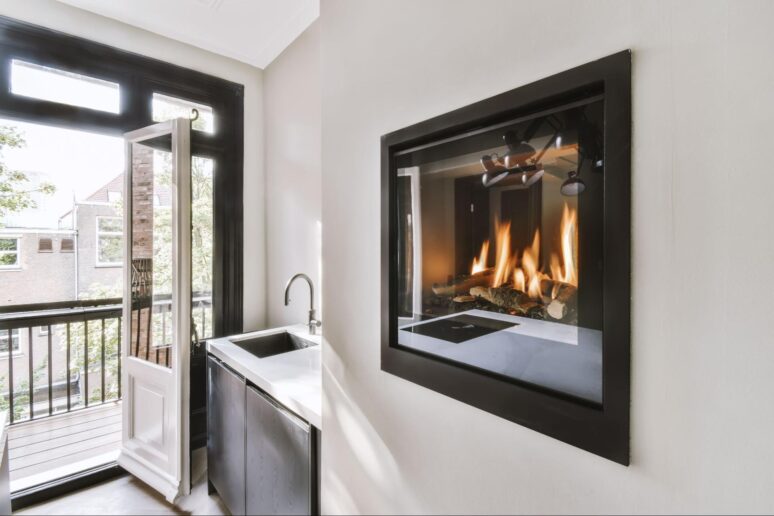
How Cassette Stoves Work
At first glance, a cassette stove may seem like a simple box of glass and steel, but there’s quite a bit going on under the surface. These stoves are engineered to burn fuel cleanly, produce consistent heat, and retain warmth long after the fire dies down.
Here’s how the system works:
The Firebox
At the core is a sealed firebox, where seasoned wood, logs, or smokeless coal are burned. This box is lined with insulating materials – like vermiculite panels or firebricks – that help concentrate the heat and boost combustion temperatures.
Airflow and Combustion
Air vents are used to control the flow of oxygen into the firebox, which in turn controls the rate of burn and heat output. Many cassette stoves have primary, secondary, and tertiary air systems:
- Primary air feeds the base of the fire for starting and burning fuel.
- Secondary air enters above the flames, helping to ignite unburnt gases and reduce emissions.
- Tertiary air further improves efficiency and lowers smoke output, often required for DEFRA approved status.
By managing these airflows, a cassette stove ensures clean, complete combustion and minimal waste.
Heat Transfer
The heat generated in the firebox radiates through the glass door and is also convected through integrated ducts or vents. Some models feature built-in fans or heat recovery systems that push hot air further into the room or even into adjacent rooms – making them ideal for heating a larger space.
Flue and Smoke Control
All this wouldn’t work without a properly fitted flue liner, which carries away smoke and gases safely up the chimney. The flue is often lined with stainless steel to prevent creosote buildup and ensure smooth airflow. In some cases, a twin-wall flue system is installed if no existing chimney is present.
Viewing and Safety
One of the most satisfying aspects of a cassette stove is the ability to watch the flames through the clean, heat-resistant glass door. These doors typically feature an air-wash system that keeps the glass clear by directing a thin layer of air over the inside surface.
Because the stove is sealed, it’s also safer. The combustibles stay behind closed doors, and there’s little risk of sparks jumping out into the room.
In short, cassette stoves offer a smart blend of form and function – clean burning, highly efficient, and built to keep your homewarm and stylish with minimal fuss.
Choosing the Right Cassette Stove
Choosing the right cassette stove isn’t just about looks – it’s about matching the appropriate heat output, fuel type, and features to your living space. Get this right, and you’ll have a reliable, long-lasting wood burner that keeps your room comfortably warm while running efficiently.
Calculate the Heat Output You Need
Start by working out how much heat your room needs. This is usually measured in kilowatts (kW). A rough estimate is 1kW of heat output for every 14 cubic metres of space, but factors like insulation, windows, and draughts can affect this.
For large rooms or open-plan areas, look for models with higher output, ideally with fans or ducting options to help circulate hot air. If you pick a stove that’s too powerful for a small room, it’ll overheat the space and burn fuel inefficiently.
Choose a Fuel Type That Suits Your Home
- Wood-burning stoves are the most common and provide the traditional experience of burning wood. Use only seasoned wood to reduce moisture and maximise efficiency.
- Multi-fuel options let you burn both logs and smokeless coal, offering flexibility.
- If your home doesn’t have a working chimney, consider a gas or electric model. They offer the aesthetic appeal of a real fire with fewer installation requirements.
Check for DEFRA Approval
If you live in a smoke control area, only install a DEFRA approved model. These stoves are designed to burn cleanly and meet air quality standards. Most major manufacturers offer a range of DEFRA-compliant cassette stoves.
Style and Finish
Consider how the stove will look in your living space. Do you want a minimalist, frameless unit that blends into the wall, or a bolder design with visible trims in steel or glass?
Make sure it complements your décor and fireplace style. Many modern cassette stoves come in black, graphite, or anthracite finishes with large viewing windows for maximum impact.
Warranty and Support
Buy from a reputable manufacturer with good customer support, clear installation instructions, and a solid warranty – ideally 5 years or more. This gives you peace of mind if any issues arise down the line.
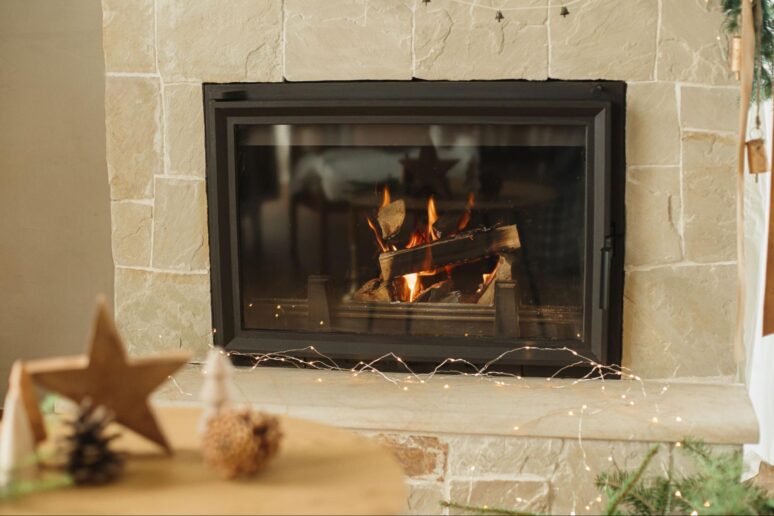
Preparing Your Home for a Cassette Stove
Before you jump into installation, it’s essential to make sure your home is ready for a cassette stove. This includes checking structural conditions, ensuring proper ventilation, and making sure you’re set up for safe operation.
Assess the Chimney Breast or Wall
If you already have an existing fireplace, you may be able to retrofit a cassette stove into it. You’ll need to check:
- The dimensions of the opening – it must accommodate the firebox and allow space for insulation and air flow.
- The structural soundness of the chimney breast – it must support the stove and handle the heat produced.
If you don’t have a fireplace, you’ll need to create a new recess in a non-combustible wall. This is a more involved process and usually requires professional input. If you need any heat-resistant materials, you can get them in an online shop – Vitcas has everything you’ll need.
Flue Liner and Chimney Check
A functioning flue is non-negotiable. In most cases, you’ll have to install a flue liner – typically a stainless-steel tube – that runs inside your chimney and connects to the back of the cassette stove.
This ensures smoke is drawn out safely and improves the stove’s efficiency. An old or unlined chimney can leak gases or reduce heat output drastically.
If your home doesn’t have a chimney, a twin-wall flue system can be routed externally through a wall and up the side of the house.
Air Supply and Ventilation
Modern cassette stoves are tightly sealed and require a good air supply for combustion. In older, draughty houses, this typically isn’t a problem, but well-insulated modern homes may need a dedicated air vent installed.
Without enough oxygen, your wood burner won’t perform efficiently and could become dangerous.
Clearances and Safety Regulations
You’ll need to follow UK building regulations for minimum clearance distances between the stove and any combustibles. These vary by model, so check the manufacturer’s specs.
Moreover, your hearth must be constructed from a suitable non-combustible material and meet the required size and thickness.
Smoke and Carbon Monoxide Detectors
It’s a legal requirement to fit a carbon monoxide alarm in any room with a wood-burning stove. A smoke detector is strongly recommended as well.
Building or Installing a Cassette Stove
Installing a cassette stove is not a simple plug-and-play task. Whether you’re fitting it into an existing fireplace or creating a new recess in the wall, the job requires precision, safety knowledge, and compliance with UK building regulations. Here’s a step-by-step breakdown of what’s involved.
1. Plan the Position
Start by deciding where the cassette stove will go. If you’re working with an existing fireplace, make sure the opening is large enough to house the stove and allow for proper air circulation and insulation. If you’re building a new recess, ensure it’s structurally sound and finished in non-combustible materials.
Most people choose to install the stove at floor level, but eye-level placements are also possible and add strong aesthetic appeal – particularly in feature walls.
2. Prepare the Opening
The recess must match the cassette stove dimensions while allowing space around the firebox for insulation. Line the cavity with fireboard or steel, and check that the surrounding structure is free of combustibles.
If needed, build a new hearth from stone, glass, or slate that complies with UK regulations for thickness and projection.
3. Install the Flue Liner
The flue liner is essential. If you’re using an existing chimney, drop a stainless-steel flue liner down the shaft and connect it to the stove’s flue outlet. For homes without chimneys, a twin-wall flue can be routed through the wall and up the exterior of the house.
The flue must be properly sealed and insulated to prevent leaks and condensation.
4. Fit the Stove
Slide the cassette stove into the opening, ensuring it sits flush with the wall. Connect it securely to the flue and double-check all seals and joints. Use fire cement or high-temperature sealants as required by the manufacturer’s instructions.
5. Test and Certify
Before use, the system must be pressure-tested to confirm proper draw and smoke clearance. A smoke pellet test can reveal leaks or poor flue performance.
Only a HETAS-registered installer or your local authority can sign off the work legally. Certification is required for insurance and resale purposes.
6. Finishing Touches
Once the installation is approved, finish the wall around the cassette stove with tiles, render, or decorative panelling. Some people add a steel or glass trim for a sleek, modern finish that highlights the flames behind the glass door.
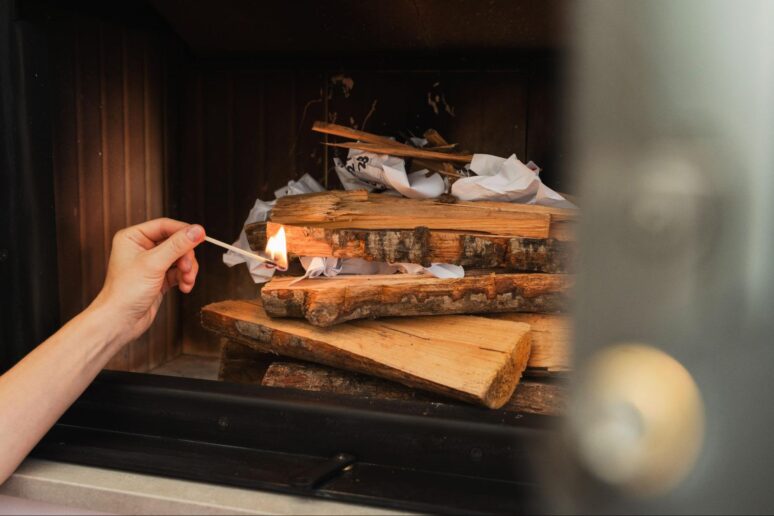
Pros and Cons of Cassette Stoves
No heating system is perfect, but cassette stoves come pretty close – offering a strong blend of efficiency, safety, and visual impact. Still, there are a few drawbacks worth knowing.
Pros
- Highly efficient: Delivers excellent heat output with less fuel.
- Sleek and modern: A stylish, integrated look with strong aesthetic appeal.
- Safe: Enclosed flames behind sealed glass reduce fire risk.
- Cleaner burning: Lower smoke emissions, especially with DEFRA approved models.
- Versatile: Works with seasoned wood, logs, or smokeless coal.
- Great for larger rooms: Provides steady warmth for larger spaces.
Cons
- Installation cost: Higher upfront cost than a freestanding wood burner or gas stove.
- Structural requirements: Needs a suitable chimney breast, wall, or built recess.
- Limited access: Maintenance and cleaning may require disassembly if access panels aren’t designed in.
- Fixed position: Once installed, it’s difficult to move – unlike freestanding stoves.
Maintenance and Safety
A cassette stove is a long-term investment, and like any other wood-burning appliance, it needs regular care to run safely and efficiently.
Routine Maintenance
- Chimney sweeping: Have your flue liner and chimney swept at least once a year to prevent creosote build-up.
- Inspect seals: Check glass door gaskets, hinges, and air vents every few months. Worn parts can affect heat output and safety.
- Clean the firebox: Remove ash regularly and empty the ash pan if fitted. Never allow ash to build up to the doors.
Fuel Tips
- Always use seasoned wood with low moisture content (under 20%) for clean burning.
- Avoid treated wood, wet logs, or anything not recommended by the manufacturer.
- If you’re burning smokeless coal, make sure your cassette stove is rated for multi-fuel use.
Safety Equipment
- Install a carbon monoxide alarm in the same room as your stove – this is a legal requirement in the UK.
- A smoke alarm is also highly recommended, especially if the cassette stove is used daily.
- Keep combustibles well away from the hearth and surrounding area. Always follow the manufacturer’s clearance guidelines.
Proper maintenance ensures that your cassette stove continues to provide safe, efficient, and reliable warmth through every season.
Conclusion
A cassette stove is the perfect solution for anyone wanting the beauty of a real fire with modern-day efficiency and safety. Whether you’re upgrading an existing fireplace or building from scratch, the aesthetic appeal, heat output, and long-term benefits make it a solid investment for any house. Just ensure you use the right manufacturer, plan the installation carefully, and match the stove to your space. With the proper setup, you’ll enjoy years of warmth, style, and the cosy atmosphere only burning wood can provide.

